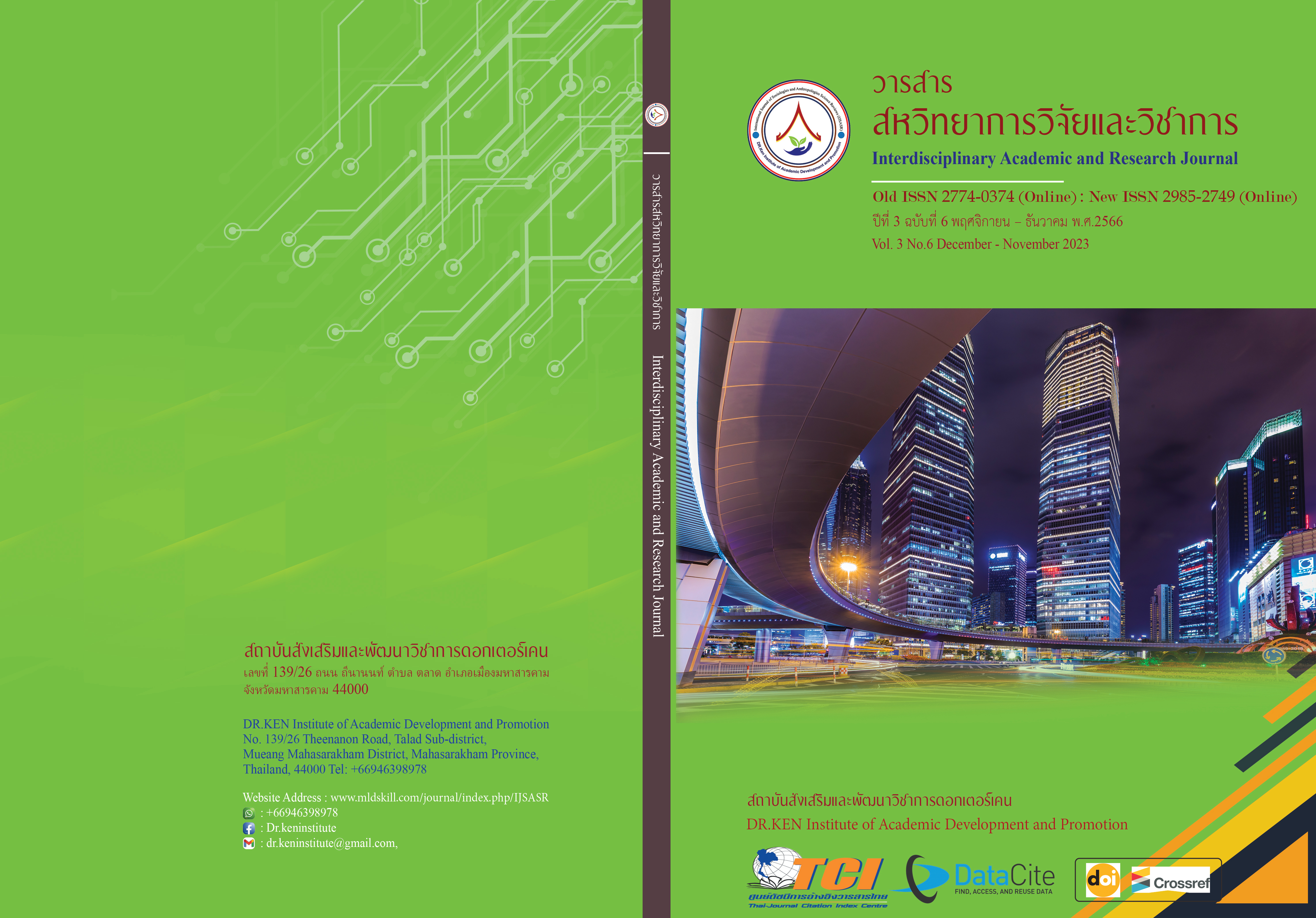The Development of Drawing Practical Skills Learning Activities with Colored Pencils Techniques Using Experiential for Prathomsuksa 3 Students
DOI:
https://doi.org/10.60027/iarj.2023.271779Keywords:
Learning Activity Management; , Experiential; , Practical Skills;, DrawingAbstract
Background and Aims: The most common problem in teaching art at the primary level is the lack of teachers with knowledge, ability, and expertise in art. The second problem is the lack of various teaching media and the media is not as effective as it should be. Most teachers lack knowledge and understanding of media production. Most teacher's teaching methods still use lecture-based teaching methods, causing students to become bored and not interested in learning as much as they should, resulting in students being unable to develop their own potential. This research aimed 1) To develop drawing practical skills learning activities with colored pencils techniques using experiential for Prathomsuksa 3 students to meet the efficiency criterion of 80/80 2) To compare drawing practical skills learning activities with colored pencils techniques using experiential for Prathomsuksa 3 students, between after learning and meet the criterion of 80 3) To compare the achievement of Prathomsuksa 3 students, before and after learning with drawing practical skills learning activities with colored pencils techniques using experiential and 4) To study the students satisfaction with drawing practical skills learning activities with colored pencils techniques using experiential.
Methodology: The sample group consisted of 38 Prathomsuksa 3 Students in the first semester of the academic year 2020 in Anuban Kitiya School, Maha Sarakham selected through the Cluster Sampling. The research instrument consisted of 1) learning organization plans an achievement test 3) a drawing paint practice skills assessment and 4) a satisfaction questionnaire. The statistics data were analyzed by using percentage, mean, standard deviation, and t-test Dependent Samples.
Results: 1) Organizing drawing practical skills learning activities with colored pencils techniques using experiential for Prathomsuksa 3 students revealed the efficiency of 84.70/85.66 higher than the preset criterion 2) The students’ drawing paint practice skills through drawing practical skills learning activities with colored pencils techniques using experiential after learning were higher than the 80 percentage criteria, with statistical significance at the level of .05 3) The student’s achievement through drawing practical skills learning activities with colored pencils techniques using experiential after learning was higher than before learning, with statistical significance at the level of .05 and 4) Satisfied with the drawing practical skills learning activities with colored pencils techniques using experiential in high level.
Conclusion: Learning activities for painting skills using the wood coloring technique that emphasizes experiences for Grade 3 students are more effective than the specified criteria. The student's drawing and painting skills after learning are significantly higher than the criteria of 80% statistically at the .05 level, and academic achievement and satisfaction with this learning activity are still higher than the standard level.
References
กมลวรรณ ตังธนกานนท์. (2559). การวัดและประเมินทักษะการปฏิบัติ. พิมพ์ครั้งที่ 2. กรุงเทพฯ: สำนักพิมพ์แห่งจุฬาลงกรณ์มหาวิทยาลัย.
เกศินี กี่จนา. (2558). การสร้างชุดกิจกรรมทัศนศิลป์เพื่อพัฒนาความสามารถในการปฏิบัติงานศิลปะและความคิดสร้างสรรค์ สำหรับนักเรียนชั้นประถมศึกษาปีที่ 1. วิทยานิพนธ์การศึกษาศาสตรมหาบัณฑิต: มหาวิทยาลัยบูรพา.
เจษฎากร ตันตราจิณ. (2561). การพัฒนาความคิดสร้างสรรค์ วิชาทัศนศิลป์ โดยใช้การจัดการเรียนรู้แบบประสบการณ์ สำหรับนักเรียนชั้นประถมศึกษาปีที่ 4. วิทยานิพนธ์ศึกษาศาสตรมหาบัณฑิต: มหาวิทยาลัยธุรกิจบัณฑิตย์.
ชัยวัฒน์ ชุมศิริวงษ์. (2559). ผลการใช้ชุดกิจกรรมการเรียนรู้ เรื่องทัศนศิลป์กับการวาคภาพระบายสี กลุ่มสาระการเรียนรู้ศิลปะ (สาระทัศนศิลป์) สำหรับนักเรียนชั้นประถมศึกษาปีที่ 6. วิทยานิพนธ์ปริญญาครุศาสตรมหาบัณฑิต: มหาวิทยาลัยราชภัฏบุรีรัมย์.
ชัยวัฒน์ สุทธิรัตน์. (2561). 80 นวัตกรรมการจัดการเรียนรู้ที่เน้นผู้เรียนเป็นสำคัญ. พิมพ์ครั้งที่ 8. นนทบุรี: พีบาลานซ์ดีไซด์แอนปริ้นติ้ง.
นิตยา วงศ์ชู. (2555). การพัฒนาความคิดสร้างสรรค์ทางศิลปะ เรื่องการวาดภาพระบายสีของนักเรียนชั้นประถมศึกษาปีที่ 5 โดยการจัดการเรียนรู้แบบส่งเสริมความคิดสร้างสรรค์. วารสารศึกษาศาสตร์ ฉบับวิจัยบัณฑิตศึกษา, 35(4), 42-49.
นุชนารถ สมวาที. (2560). การพัฒนาชุดการสอนกลุ่มสาระการเรียนรู้ศิลปะ เรื่อง ทัศนธาตุสู่การสร้างสรรค์ สำหรับนักเรียนชั้นประถมศึกษาปีที่ 3. วิทยานิพนธ์การศึกษาศาสตรมหาบัณฑิต: มหาวิทยาลัยบูรพา.
ปัญญาพร แพนดี. (2558). การพัฒนาชุดกิจกรรมการเรียนรู้ตามแนวทฤษฎีการสร้างองค์ความรู้ เรื่อง การวาดภาพระบายสี สำหรับนักเรียนชั้นประถมศึกษาปีที่ 2. วิทยานิพนธ์ครุศาสตรมหาบัณฑิต: มหาวิทยาลัยราชภัฏบุรีรัมย์.
มุทิตา อังคุระษี. (2559). การพัฒนาแบบฝึกทักษะเรื่องสีและการระบายสี กลุ่มสาระการเรียนรู้ศิลปะ สำหรับนักเรียนขั้นประถมศึกษาปีที่ 4 โรงเรียนคลองสำโรง. วิทยานิพนธ์ปริญญาครุศาสตรมหาบัณฑิต: มหาวิทยาลัยราชภัฏธนบุรี.
โรงเรียนอนุบาลกิติยา. (2562). รายงานผลสัมฤทธิ์ทางการเรียนของกลุ่มสาระการเรียนรู้ศิลปะ ปีการศึกษา 2561. มหาสารคาม: โรงเรียนอนุบาลกิติยา.
โรงเรียนอนุบาลกิติยา. (2562). รายงานผลสัมฤทธิ์ทางการเรียนของกลุ่มสาระการเรียนรู้ศิลปะ ปีการศึกษา 2561. มหาสารคาม: โรงเรียนอนุบาลกิติยา.
โรงเรียนอนุบาลกิติยา. (2563). รายงานผลสัมฤทธิ์ทางการเรียนของกลุ่มสาระการเรียนรู้ศิลปะ ปีการศึกษา 2562. มหาสารคาม: โรงเรียนอนุบาลกิติยา.
Dewey, J. (1974). John Dewey, On Education: Selected Writings Phoenix edition. University Of Chicago Press.
Efstratia, D. (2014). Experiential education through project-based learning. Procedia-Social and Behavioral Science, 152(2014), 1256-1260.
Kolb, D.A. (1984). Experiential learning: Experience as the source of learning and Development. Englewood Cliffs, NJ: Prentice.
Downloads
Published
How to Cite
Issue
Section
License
Copyright (c) 2023 Mutita Hongsanawa, Poosit Boontongtherng

This work is licensed under a Creative Commons Attribution-NonCommercial-NoDerivatives 4.0 International License.
Copyright on any article in the Interdisciplinary Academic and Research Journal is retained by the author(s) under the under the Creative Commons Attribution-NonCommercial-NoDerivatives 4.0 International License. Permission to use text, content, images, etc. of publication. Any user to read, download, copy, distribute, print, search, or link to the full texts of articles, crawl them for indexing, pass them as data to software, or use them for any other lawful purpose. But do not use it for commercial use or with the intent to benefit any business.
















.png)


